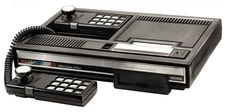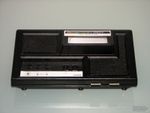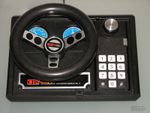Difference between revisions of "ColecoVision"
Jump to navigation
Jump to search
m |
(→Technical specifications) |
||
| Line 19: | Line 19: | ||
*ROM: 8 KB Texas Instruments TMS4764NL Mask ROM | *ROM: 8 KB Texas Instruments TMS4764NL Mask ROM | ||
*Storage: Cartridge: 8/16/24/32 KB | *Storage: Cartridge: 8/16/24/32 KB | ||
| + | ===Expansion Modules=== | ||
| + | *'''[[File:ColecoVision-Module1.jpg|150px|right]]Expansion Module #1''' makes the ColecoVision compatible with the [[Atari 2600]]. Functionally, this gave the ColecoVision the largest software library of any console of its day. The expansion module prompted legal action from Atari, but Atari was unable to stop sales of the module because the 2600 could be reproduced with off the shelf parts. Coleco also designed and sold the Gemini game system, which was a clone of the 2600, but with combined joystick/paddle controllers. | ||
| + | *'''[[File:ColecoVision-Module2.jpg|150px|right]]Expansion Module #2''' is a driving controller (steering wheel / gas pedal) that came packaged with a port of the arcade game ''Turbo''. The gas pedal is merely a simple on/off switch, so many games used the second ColecoVision controller as a gear shift for more precise speed control. Even though it's called "an expansion module", it actually plugs into the controller port, not into the Expansion Module Interface. | ||
| + | *'''Expansion Module #3''' converts the ColecoVision into a full-fledged computer known as the Adam, complete with keyboard, digital data pack (DDP) cassette drives and printer. | ||
==Power Supply== | ==Power Supply== | ||
Revision as of 20:53, 1 June 2013
[[File: |230px]] |230px]]
| |
| Manufacturer | Coleco |
|---|---|
| Generation | Second generation |
| Release date | August 1982 (US) 1982 (EU) |
| Media type | ROM cartridge |
| Predecessor | Telstar Arcade |
The ColecoVision is Coleco's second generation home video game console, which was released in August 1982. The ColecoVision offered near-arcade-quality graphics and gaming style along with the means to expand the system's basic hardware. Released with a catalog of 12 launch titles, with an additional 10 games announced for 1982, approximately 145 titles in total were published as ROM cartridges for the system between 1982 and 1984. River West Brands currently owns the ColecoVision brand name.
Technical specifications
- CPU: NEC D780C-1 (NEC version of Zilog Z80A @ 3.58 MHz)
- Video processor: Texas Instruments TMS9928A (40 Pin DIP)
- 256×192 resolution
- 32 Sprites
- 16 colors
- Sound: Texas Instruments SN76489A
- 3 tone generators
- 1 noise generator
- VRAM: 16 KB ITT 8244 4116 3N (These are 16K by 1 bit chips, thus there are 8 of them)
- RAM: 1 KB (2 x UPD2114LC 1024 X 4-bit SRAM (two chips for 1 KB of memory)
- ROM: 8 KB Texas Instruments TMS4764NL Mask ROM
- Storage: Cartridge: 8/16/24/32 KB
Expansion Modules
- Expansion Module #1 makes the ColecoVision compatible with the Atari 2600. Functionally, this gave the ColecoVision the largest software library of any console of its day. The expansion module prompted legal action from Atari, but Atari was unable to stop sales of the module because the 2600 could be reproduced with off the shelf parts. Coleco also designed and sold the Gemini game system, which was a clone of the 2600, but with combined joystick/paddle controllers.
- Expansion Module #2 is a driving controller (steering wheel / gas pedal) that came packaged with a port of the arcade game Turbo. The gas pedal is merely a simple on/off switch, so many games used the second ColecoVision controller as a gear shift for more precise speed control. Even though it's called "an expansion module", it actually plugs into the controller port, not into the Expansion Module Interface.
- Expansion Module #3 converts the ColecoVision into a full-fledged computer known as the Adam, complete with keyboard, digital data pack (DDP) cassette drives and printer.
Power Supply
| Input | 120V AC-60Hz, 0.25A |
| Output |
Pin 1: +5V DC, 0.9A Pin 2: -5V DC, 0.1A Pin 3: +12V DC, 0.3A Pin 4: GROUND |




